How to Fix “Error code: 5” in Chrome Browser?
Chrome Error code 5 is a type of “runtime error.” A runtime error occurs when a program you are using or writing crashes or produces a wrong output. This can occur due to a bug in the programs code, corrupted cache files or conflicts with your computer’s hardware, etc.

Why does Runtime Error 5 occur?
Runtime Error 5 occurs because there is an issue with the Google Chrome program code. There are different types of this error.
- Catastrophe of this error – This error can cause your entire computer to freeze and may even lead to a crash. It occurs when Google Chrome cannot process the information it has received.
- Memory Leak – This happens when Google Chrome uses up too much memory on your computer. This could be because the program isn’t freeing up memory like it’s supposed to, or there’s a problem with the program code that makes it run in an endless loop.
- Logic Error – This type of error happens when Google Chrome gets the right information but gives back the wrong result. It’s caused by a problem in the program code that messes with how information is processed.
Sometimes, Chrome Error 5 is caused by a misplaced file within Chrome, which may have been accidentally deleted or moved. This issue can often be resolved by the software itself as it downloads and installs the latest file from Google. Additionally, this error may occur if your computer’s Windows registry attempts to use a non-existing file. In such cases, scanning and fixing your registry should remedy the problem.
Solutions to fix Chrome Error Code 5
To fix this run-time error, you will need to perform these fixes one by one until the problem disappears.
- Clearing the Browser Cache.
- Launching Chrome with administrator privileges.
- Removing Faulty Extensions.
- Resetting the Browser to Default settings.
- Reinstalling the Browser.
- Scanning Computer for Malware and Viruses.
- Try using a different browser.
1. Clearing the Browser Cache
Sometimes, simply clearing your browser cache can resolve the issue. The cache stores information from sites you’ve visited to help pages load faster. However, when these files can get corrupted, causing issues like this one. To clear Chromes cache, follow these steps:
- Open Chrome and press the three dots on the top right of the screen.
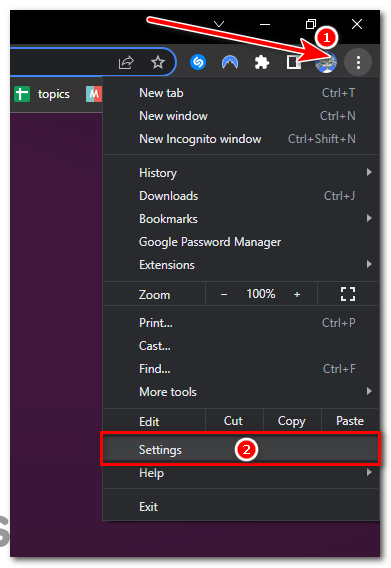
Press the three dots on the top right of the screen. - Open settings and navigate to “Privacy and Security.”
- In Privacy and Security, click on “clear browsing data.”
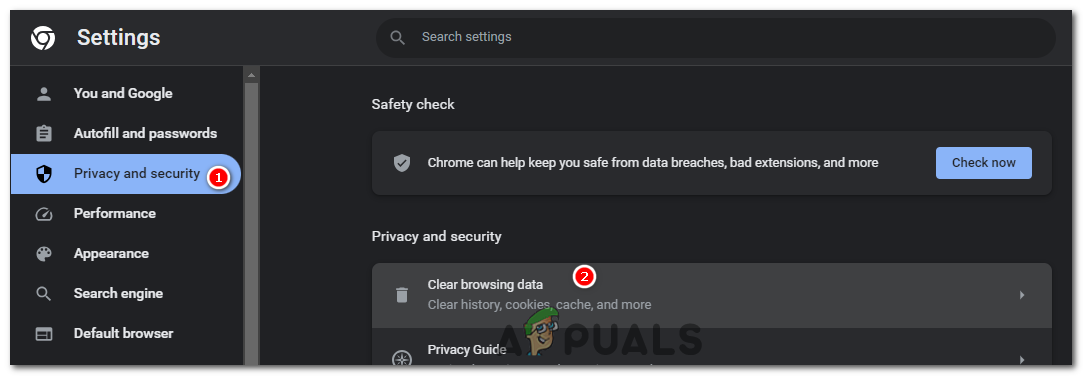
In the Privacy and Security tab, click on “clear browsing data.” - In clear browsing data, open the time range and select “All time.”
- Uncheck “Browsing history”, “Cookies and other site data” and Check the option “Caches images and files.”
- Press Clear data to clear the browser cache.
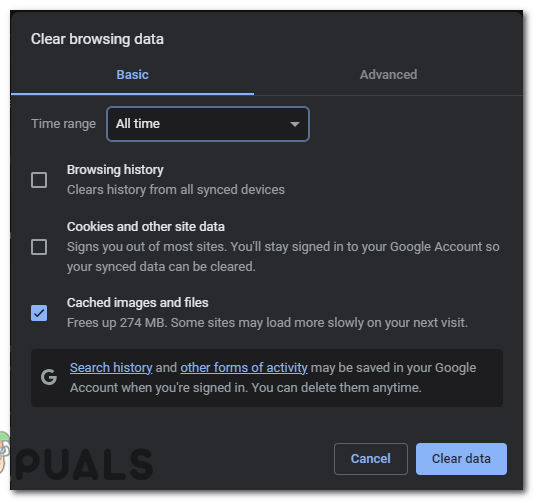
Press Clear data to clear the browser cache.
If the problem was with a corrupted cache file, this should fix it, and the error should not occur again. But if this does not fix it, carry out the next fix.
2. Launching Chrome with administrator privileges
Launching Chrome with administrator privileges can resolve the error. This error can also occur due to insufficient permissions, which prevents Chrome from carrying out certain operations, such as updates. By running Chrome as an administrator, you provide the browser with the necessary permissions to carry out its tasks without obstruction.
- Press the Windows key to open the Start menu.
- Type “Google Chrome” in the search bar.
- Right click on Google Chrome and select the option “Run as administrator.”
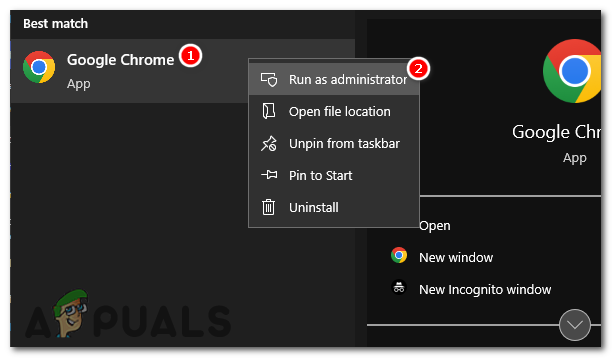
Right click on Google Chrome and select the option “Run as administrator.” - This will launch the program with administrator privileges.
3. Removing Faulty Extensions
Extensions can greatly enhance your browsing experience by adding new features and capabilities to Chrome. However, faulty or malicious extensions can cause various issues, including Chrome Error Code 5. They can interfere with Chrome’s regular operations, including updates, thus leading to error messages. Here’s how faulty extensions can be identified and removed to fix the error:
Identifying Faulty Extensions
To identify the faulty extension causing the issue, you’ll need to disable all your extensions and then re-enable them one at a time, checking if the error reappears each time.
- In the Chrome address bar, type chrome://extensions/ and press Enter. This will bring up the Extensions page.
chrome://extensions/

- Use the toggle switch on the top right of the screen named “Developer Mode” to disable all your extensions.
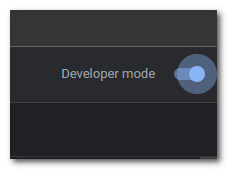
Toggle Developer Mode off to disable all the extensions. - Restart Chrome and check if the error is resolved.
If the error doesn’t appear, it’s likely one of the extensions was causing the issue. You can identify which one by re-enabling the extensions one by one, checking each time if the error reappears.
Removing the Faulty Extension
Once the problematic extension is identified, you can proceed to remove it:
- Go back to the Extensions page (chrome://extensions/).
- Enable one extension at a time and use Chrome.
- Once the error returns, just remove the last extension you enabled.
- Find the faulty extension and click on “Remove”. A confirmation box will appear.
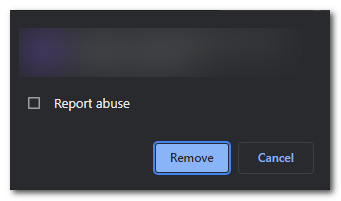
- Click “Remove” again to confirm your action.
Removing faulty extensions not only can help in resolving Chrome Error Code 5 but can also improve your browser’s overall performance and security. It’s a good practice to regularly review and manage your extensions, keeping only those that you actively use and trust.
4. Resetting the Browser to Default settings
When you reset Chrome, you are effectively erasing all your personalized settings, clearing the cache and cookies, disabling all extensions, and returning Chrome to its original ‘fresh install’ state.
This error can be caused by an array of issues, from problematic extensions to corrupted files in your cache. When you reset the browser, you remove these potential problems. In essence, you are giving Chrome a clean state to operate from, free from any elements that may have been causing the error. Here’s how you can reset Chrome:
- Open Chrome, click on the three dots in the upper right hand corner to open the menu, then click on “Settings”.

Click on the three dots in the upper right hand corner to open the menu, then click on “Settings”. - Scroll down to the bottom and click on “Reset settings.”
- In the “Reset settings” tab, click on “Restore settings to their original defaults”.
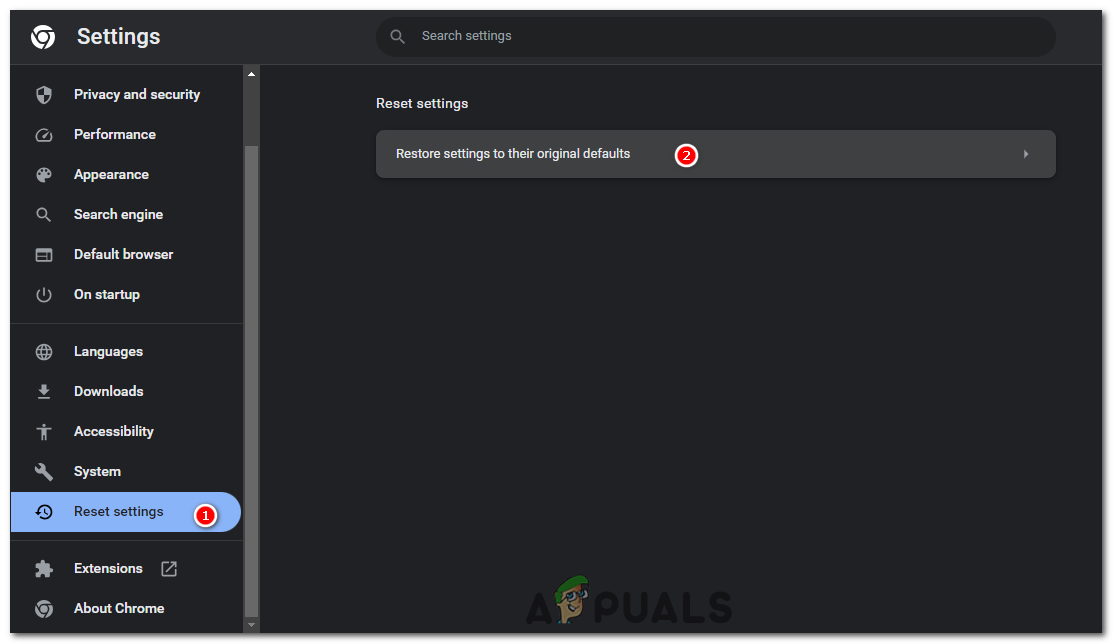
In the “Reset settings” tab, click on “Restore settings to their original defaults”. - A box will appear warning you that your startup page, new tab page, search engine, and pinned tabs will be reset, and extensions will be disabled. Click “Reset settings” to confirm.
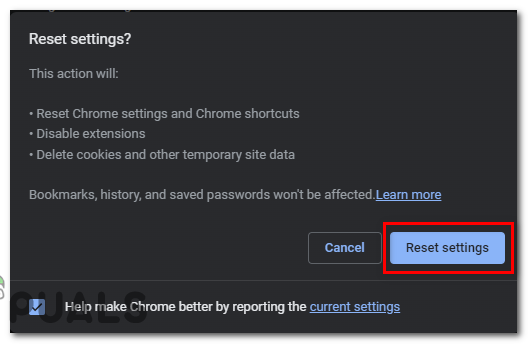
Click “Reset settings” to confirm.
Keep in mind that this step won’t erase your bookmarks, history, or saved passwords, so you won’t lose any critical information.
Remember, this is a fairly broad sweep solution. If resetting Chrome resolves the error, you might still want to invest time in finding out what caused the problem in the first place (be it a certain setting or a specific extension) to avoid encountering the same issue in the future.
5. Reinstalling the Browser
Reinstalling Chrome will remove all corrupted files and problematic settings within the browser. Sometimes, issues might persist even after clearing the cache, removing extensions, or resetting the browser. In such cases, reinstalling Chrome entirely can provide a fresh start, ensuring that all the elements of the browser are in their original, uncorrupted state. To reinstall Chrome, you first need to uninstall it. Here’s how to do this:
- Click the Windows Start button and type “Control Panel” in the search bar, then select it from the results.
- In the Control Panel window, select “Uninstall a program” under the Programs section.

In the Control Panel window, select “Uninstall a program” under the Programs section. - Scroll through the list of installed programs until you find Google Chrome. Right click on it and then click “Uninstall”.
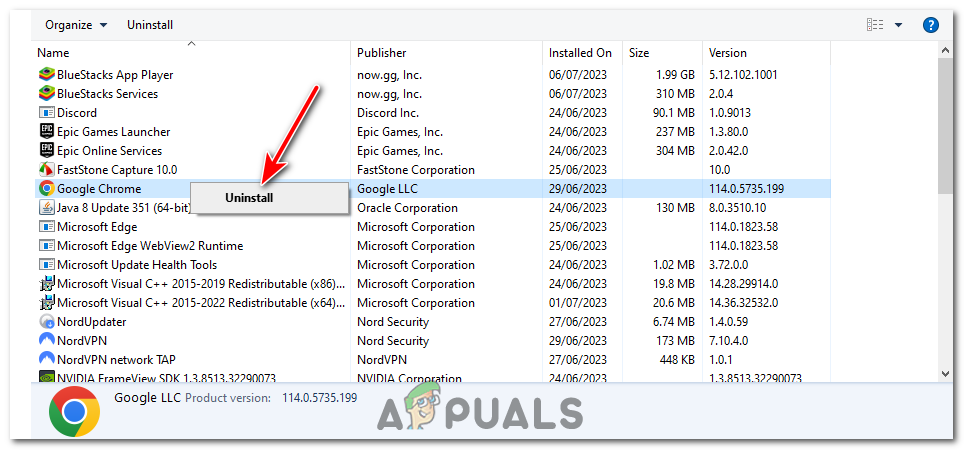
Find Google Chrome, right click on it and then click “Uninstall”. - Confirm your decision to uninstall the browser.
After you’ve uninstalled Chrome, you can proceed to reinstall it:
- Open another browser (e.g. Microsoft Edge) and go to the official Google Chrome download page.
Click “Download Chrome”.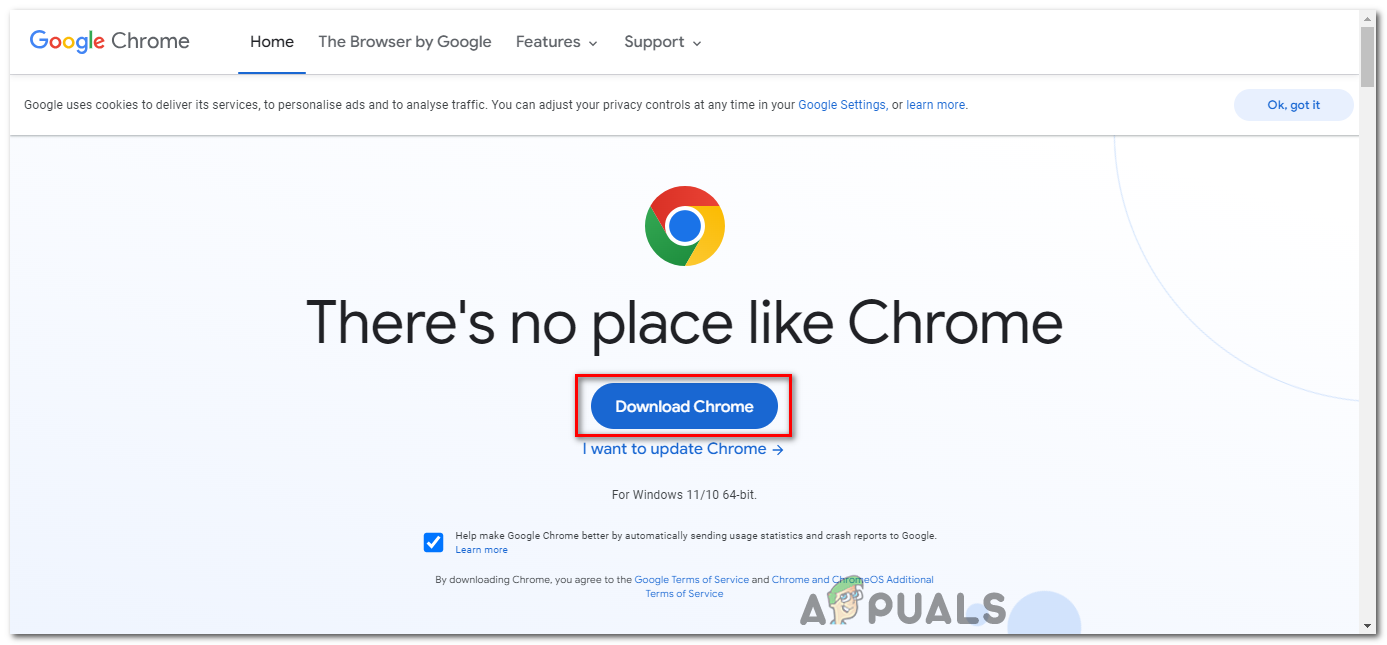
- Run the installer after it’s downloaded. It will automatically download the latest version of Chrome and install it.
Remember to back up any important data like bookmarks or saved passwords before you uninstall Chrome, as this process will remove all your personal data associated with the browser.
6. Scanning Computer for Malware and Viruses
Malware and viruses can be a root cause of various issues on your computer, including this particular error with Chrome. They can manipulate or corrupt system files and processes, leading to unusual errors and performance issues. In particular, if a malware targets your browsers or network settings, it could trigger errors like Chrome Error Code 5.
Scanning your computer for malware and viruses, and subsequently removing any that are found, can help fix these issues. This process ensures that your system is clean from malicious programs that might interfere with the normal functioning of applications, like Chrome.
- Click on the Windows Start button and type “Windows Security” in the search bar, then select it from the results.
- In the Windows Security window, select “Virus & threat protection”.
- Under the “Current threats” section, select “Quick scan” to run a quick scan of your system.
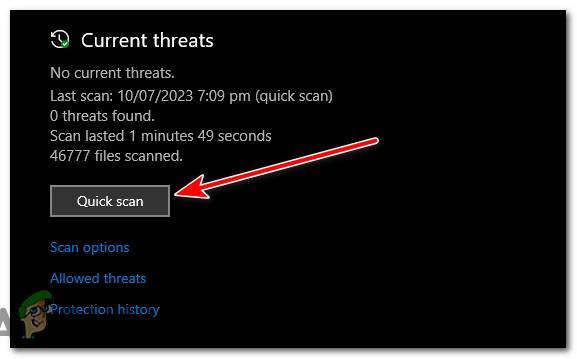
Under the “Current threats” section, select “Quick scan” to run a quick scan of your system. - Alternatively, for a more thorough check, select “Scan options” > “Full scan” > “Scan now”. Keep in mind that a full scan may take a while to complete, depending on the speed of your storage drives.
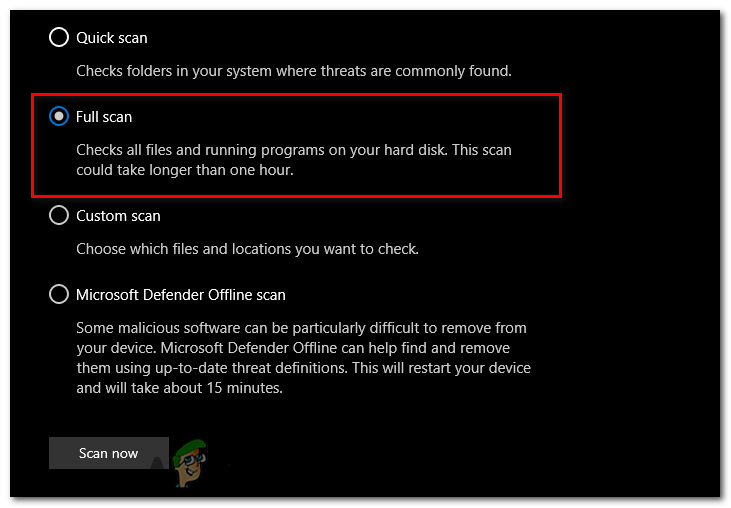
- If Windows Defender finds any threats, it will alert you and provide recommendations for dealing with them. Follow the instructions to quarantine or remove the threats.
Regular scanning of your system is a good practice to keep it safe and ensure smooth performance. Additionally, be cautious while downloading files or visiting websites to avoid inadvertently introducing malicious software into your system.
7. Try using a different browser
If you are still consistently facing this error and none of the mentioned solutions are working, one of the final options is to temporarily switch to a different browser. While this does not exactly ‘fix’ the error, it provides a workaround that allows you to continue browsing the internet without being hindered by the error.
To choose a new browser, refer to this guide that has great alternatives for those who want to try something other than Chrome: The 7 Best Web Browsers For Every Kind of User – 2023 Edition.
Before you make the switch, ensure that you export your bookmarks and other important data from Chrome so you can import them to the new browser. Each browser generally has a ‘Import/Export’ option in their settings to make this process easier.
Chrome Error Code 5 - FAQs
Not always. It is only necessary if you have exhausted all other troubleshooting steps and believe the issue lies with your internet connection.
Resetting Chrome won’t erase your bookmarks, history, or saved passwords. However, uninstalling Chrome will remove all your personal data associated with the browser if you don’t have Chrome Sync turned ON, so it is advised to backup important data like bookmarks or saved passwords before you proceed with reinstallation.
If you have tried all the solutions and the error still persists, it might be a more complex issue that requires professional help. You can contact Google Support, get help from a tech savvy friend, or consult with a professional tech support service.
While the instructions provided are Windows-specific, similar steps can be taken on Mac and Linux systems. The processes might vary slightly due to the differences in operating systems, but the general methods like clearing cache, reinstalling the browser, or resetting settings apply across all platforms.
While the error can disrupt your browsing experience, it does not directly harm your computer or compromise your data. However, if the error is caused by malware, there could be potential risks, which is why running a malware scan is recommended.
 Reviewed by
Reviewed by 




